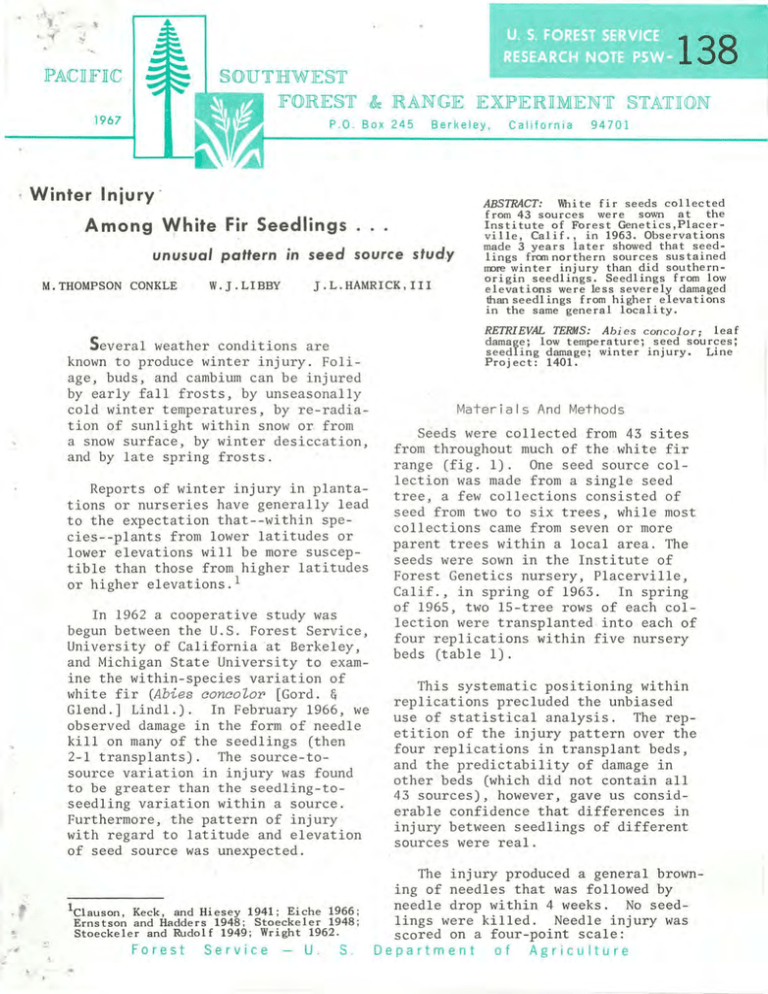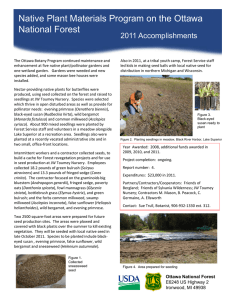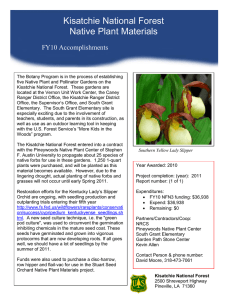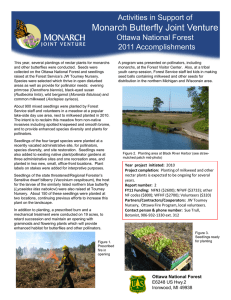. .. ~~ 138
advertisement

. l. ... -; ~~ 138 lPACTIlFTI<C §OUTHWJE§T FORJE§T & RANGJE JEXJPJERJIMJENT §TATJION 19 6 7 P.O . Box 245 Berkeley. , Winter Injury ' California 94701 ABSTRACT: White fir seeds collected from 43 sources were sown at the Institute of Forest Genetics.Pla~er­ ville. Calif .• in 1963. ObservatIons made 3 years later showed that s~ed­ lings from northern sourc~s sustaIned more winter injury than dId southernorigin seedlings. Seedlings from low elevations were less severely dam~ged than seedlings from higher. elevations in the same general localIty. Among White Fir Seedlings unusual pattern in seed source study M.THOMPSON CONKLE W. J .L.HAMRICK. J. LIBBY III RETRIEVAL TERMS: Several weather conditions are known to produce winter injury. Foliage, buds, and cambium can be injured by early fall frosts, by unseasonally cold winter temperatures, by re-radiation of sun l ight within snow or from a snow surface, by winter desiccation, and by late spring frosts. Reports of winter injury in plantations or nurseries have generally lead to the expectation that--within species--plants from lower latitudes or lower elevations wi l l be more susceptible than those from higher latitudes . 1 or higher elevatlons. In 1962 a cooperative study was begun between the U.S. Forest Service, University of California at Berkeley, and Michigan State University to examine the within-species variation of white fir (Abies concolor [Gord. & Glend.] Lind!.). In February 1966, we observed damage in the form of needle kill on many of the seedlings (then 2-1 transplants). The source-tosource variation in injury was found to be greater than the seedling-toseedling variation within a source. Furthermore, the pattern of injury with regard to latitude and elevation of seed source was unexpected. 1Clauson Keck and Hiesey 1941; Eiche 1966; Ernstso~ and Badders 1948; Sto~ckeler 1948; Stoeckeler and Rudolf 1949; WrIght 1962. F orest Serv i ce - U. S. Abies concolor; leaf damage; low temperature; .s~ed sour~es; seedling damage; winter InjUry. LIne Project: 1401. Materia l s And Methods Seeds were collected from 43 sites from throughout much of the white fir range (fig. 1). One seed source col lection was made from a single seed tree, a few collections consisted of seed from two to six trees, while most collections came from seven or more parent trees within a local area. The seeds were sown in the Institute of Forest Genetics nursery, Placerville, Calif., in spring of 1963. In spring of 1965, two IS-tree rows of each collection were transplanted into each of four replications within five nursery beds (table 1). This systematic positioning within replications precluded the unbiased use of statistical analysis. The repetition of the injury pattern over the four replications in transplant beds, and the predictability of damage in other beds (which did not contain all 43 sources), however, gave us considerable confidence that differences in injury between seedlings of different sources were real. The injury produced a general browning of needles that was followed by needle drop within 4 weeks. No seed lings were killed. Needle injury was scored on a four - point scale: Department of Agriculture . .. . .i· ,. ----- --'- BF o '- '- '- oAR oAS BB oAT ol 50 200 Miles c ==~I====±====±==~I o ... ...... ............ o Figure 1.--Seed collection sites and average injury value for white f i r s e edlings a t the Institute of Forest Gen e t i cs, Pla ce rvill e , Ca lif . Alphabe ti c s y mbol s a r e IFG s eed lot c odes. • o None slight (up to but not exceeding one-third of the total number of needles were injured) 2 . .. moderate (one-third to twothirds of the needles were injured) 3 ... severe (more than two-thirds of the needles were injured), injury value for the lower collection (AK) was the smallest of the four. Collection AL, although from an elevation intermediate between AK and AN-had the highest injury value. However, the percentages of seedlings with no injury for these four sources decreased as elevation of co llection increased . 1 Twenty seedlings of each collection in each replication were scored. An average injury value based on 80 seedlings was calculated for each collection . Resu lts Contrary to our expectation, the seedlings bf northern origin were the most severely damaged ~able 1). Ihose most severely damaged were from lot R collected at 5,000 feet in the Ochoco Mountains of central Oregon. In Oregon and California, from north to south, the injury values decreased in a clinal pattern. Few seedlings from sources south and east of the Sierra Nevada were injured, and in three cases no detectable injury was noted on any of the 80 plants scored. Each of the 43 population samples contained a few seed l ings with no detectable winter injury (table 1). Collection R, for instance, with 57 percent severely -injur ed seedlings, included 7 of 80 seedlings apparently uninjured. Pairs of collections--one from a higher e levation than the other-were made within five relatively limi ted geographical areas. In all five cases, seedlings from the lower elevation had less injury than seedlings from the higher e l evation (table 1). Collections AK, AL, Mvl, and AN transect El Dorado County in California at about the same latitud e but different elevations. The average Injury was negati ve ly correlated with 2-year height 2 of tr ees from Oregon, northern California, and western Nevada. Seedlings from the Oregon collections were the smallest and most severely damaged. This correlation,however, does not hold for the eastern collections and the southern California collections , which varied greatly in 2year height, but were nearly free of injury. Discussion Winter injury to plants has been attributed to three main causes: (a) intrace llular freezing (very uncommon in nature); (b) freezing and thawing of extracellular water; and (c) dehydration sometimes referred to as physiological drought (Scarth 1944) . These injuries can be related to the physiological condition of the plant. A winter -hardy plant can survive temperatures below the freezing point of water provided water is held by the proteins of the cellular protoplasm (Levitt 1956). On the other hand, plants lacking the abi lity to ret ai n "bound" water are subject to freezing of extracellular water and to plant dehydration (Peace 1962 ; Weav er and Clements 1929). Nursery records of maximum and minimum ai r temperatures, soil temperatures at depths of 1 anq 4 inches, precipitation, and wind were examined for the 5-month period preceding observations of injury symptoms. During 2Hum :- ick . .f . L . Geog r aph i c va riat'~;n in white fir . 1966 . (Unpublished master ' s thesis on file at School of Forestry , University of California, Be d celey ,) -3- Table 1. ~ -Wint er injury amon g whi te fi r seed sources , by co ll ection si te IFG seed lot Seedlings showing Latitude Longitud e Elevation No injury I Sli ght injury Feet 0 N 45 17 ' N ~J 11 44 "48' 118°31' W 118°01' 118°11' 120°45' 1 120°45 c AI 44°47 1 1 44°30 44°30 1 44°18 ; 43°00' 43°00' 42°47' 42°01 ' 42 °05' 42°21 / 42°29 ! 41 °28 ' 41 °30 1 40°45 ' 40°42' 40°27; 40°25' 39°29' AJ 39°54 ' 121:°05; NT 38°33 ' 38°54 ' 1 38°51 38°48' 37°44' 36°56' 34°50' 120°26: 120°23 1 120°00' 120°14' 118°55' 119°02' 119°10' 34°21 ' 34°10' 1 33°47 33°20' 32 ° 57 ' 1 36°15 39°02 ' 39°02' 34 °26 ' 117°40' 117°05' 116°45 ' 116°52' 1 116°35 115°35 ' 114°15 ' 114 °58 1 112°25 ' BF 34 °06 ' 35°00 1 39°20' 39°15' 39°16' a-:; 40 2S 110°56' 111 °30 ' 120°52' 120°57' 111 ° 27 ' 111 ° 44 ' ~l~j S ~J -ll V W X Y Z Ai>. AB AC AE :J-Y AI., AM AN AO AP AQ AR AS AT AU AV AW AX AY l3A BE OC :J-Y 0 0 122 05 i 121 ° 50 ' 121 ° 50 ' 122°04' 123°29 ' 122°47 1 121°15 i . f ,.' 120°55' 121 ° 29 ' 120°15' 0 i 123 40 121 °46 .' 121 ° 05 ' 121°06 ' 122°441 4 , 400 4 , 600 5,000 4 , 000 5 , 000 4 , 000 4 , 500 , 5 , 500 .. 4 , 500 5 , 200 5 , 600 5 , 000 7 , 000 5 . 400 - 6 , 000 5 , 400 4 ,\800 5 , 800 6 , 500 6 , 1006 , 200 3 , 7005 , 000 4 , 200 5 , 500 6 . 800 6 ,900 7 , 600 7 , 200 6 , 1008 , 500 6 , 200 5 , 700 5 , 500 5 , 100 5 , 600 8 , 400 7 , 500 9 , 000 6 , 9007 , 000 7 , 500 7 , 500 7 , 700 6,600 7,800 5 , 600 . I .. Moderate injury I Severe injury Average inj u r y valu e ll P e rc en t 10 14 12 19 9 10 39 30 20 35 45 56 42 78 56 50 91 80 55 46 21 16 13 11 18 23 25 12 11 16 30 30 15 24 21 8 10 24 16 19 29 31 34 23 36 22 26 35 35 32 11 18 6 14 24 1 9 20 33 50 41 44 36 57 36 16 19 33 19 7 3 10 1 6 5 0 1 1 5 2 . 09 1. 98 2 . 06 1. 88 2 . 29 1.99 1.16 1.34 1080 1. 38 74 8 17 1 .46 89 80 79 74 81 79 99 6 4 5 20 6 15 1 3 10 15 5 13 4 0 2 6 1 0 . 19 . 43 .39 , 34 . 31 .30 . 01 94 94 93 99 99 98 100 100 100 5 2 7 1 2 0 0 0 1 4 0 0 1 0 0 0 0 0 0 0 0 0 0 0 0 0 . 08 10 , 08 01 . 01 .02 . 00 . 00 . 00 99 84 43 47 99 99 0 14 15 24 1 0 1 2 26 19 0 1 0 0 16 10 0 11 0 1 0 :2 0 LOO 60 . 95 31 . 70 . 84 , 10 . 31 . 68 .96 ..; ;',- .01 .19 1.16 . 91 . 01 . 01 ~~" lSca l e used , 0"'00 injury ; l=sllght injury ; 2=moderate injury ; 3",severe in j ur y 2Brackets enc l ose col l ec t I ons t aken at a bout th e same locat i ons but at different elevations 3Brackets enc los e tr ansect taken along U. S. 50 a t low, medium , and high elevations ; on th e wes t side of the Sie~ra , and from a n east- si de population, -4- the 10 days before visible injury appeared, the maximum daily air temper·· atures ranged from SoC. to 14°C . and minimum temperatures from _2°C. to 2°C. Records of soil temperatures indicate the soil was not frozen during this period. These air temper atures are not in the range nor of the length that Daubenmire (1957) reported for winter damage to native and introduced trees and shrubs in Wash i ngton and northern Idaho. The period preceding the appearance of visible injury was also characterized by high winds and no precipitation. If the minimum temperatures did not cause the damage, dehydration by high winds seems a second plausible explanation of the cause of injury. The pattern of injury is similar to that observed for jack pine (Pinus banksiana Lamb.) and--to a les ser extent--for red pine (P. resinosa Ait.) planted in Texas. 3 All of the jack pine froze at temperatures only slightly below freezing, which occurred after warm weather in late winter had apparently triggered the pines into growing. Wright (1962, Ch. 6) points out that northern provenances of widespread species are often more susceptible to late spring or early autumn frost , although they are more resis tant to damage by winter cold. White fir has two geographic races that have been given taxonomic recognition (Lamb 1914; Sudworth 1916). One race is found in the Rocky Mountains and westward into Arizona and southern California. The second occupies the Sierra Nevada and extends through northern California into southern Oregon. In the Cascade region of northern California and Oregon, another taxonomic problem occurs. A. concolor is in close proximity with a closely related species--grand fir (A. grandis [Dougl.] Lindl.). Many authors (Lamb 1914 ; MUller 1939; Maul 1959) have commented on the difficulty of telling the two species apart in this region. Artificial hybridization is possible between these two species (Gathy 1957; Scheplitz 1956). Seedlings in the collections from the Rocky Mountains, Arizona, and southern California showed no appreciable damage. Seedlings from the Sierra Nevada, northern California, and southern Oregon sources had slight to moderate damage, with greater damage in the more northern sources. The pattern of winter injury conforms to the pattern of growth differences that have been observed. 4 The collections from the east-central Oregon and northwestern California populations which tend to be int ermed iate between A. concolor and A. grandis showed moderate to severe damage. No A. grandis sources were included, and the response of that species is unknown. Weather records from the Institute of Forest Genetics revealed no unusually severe conditions in fall of 1965. Furthermore, the seedlings appeared healthy in January, had brown needles in February, and had shed the injured needles by early March. This seems to indicate that injury occurred in mid-winter rather than in fall. We found differences between seedlings from paired collections at about the same location but from different elevations. Though some coll ec tion pairs differ ed only 400 to 700 f eet in elevation, the injury was consistently greater for seedlings from the higher elevation collections. 3personal correspondence with B . J . Zobe l , professor of forestry , North Carolina State University , Raleigh , N. C. , March 1966 . 4Eamrick , -5- J . LOp . ci to Ernstson, M., and Hadders, G. 1948. Skadegorelse a granplantor genom utterkning unter varvintern 194 7. (Damage to Norway spruce plants by drying out in the winterspring period of 1947.) Svenska SkogsvaardsForeningens Tidskr. 46 (5):310-322 . This t rend is consistent with the greater injury to se edlings from hi gher l atitudes. The Institute of Forest Genetics, at an e levation of 2,700 feet, is near th e lower limits of white fir in that area . A 1965 out-planting of seedlings from thi s s tudy at Camino, only 6 miles away, anu 500 f eet hi gher in elevation, did not show injury of the type observed i n the nursery. Other 1965 plant ations of similar seedlings at four other sites throughout northern Ca liforni a, and within the nativ e range of white fir , did not show this inj ury . Gathy , P. 1957. A propos de l 'hybride naturel Abies concolor (Cord .) Engelm. x Abies grandis Link. Silvae Genetica 6(6):186-190. Lamb, W. H. 1914. A conspectus of North American firs (exclusive of Mexico) . Soc . Amer. Foresters Proc. 9:528 -5 38, illus. Whit e fir is a favored species for Christma s tree plantations at sites outside the species' native range. Injury of the type noticed in the nursery may discourage the us e of seed from Oregon and northern California in such plantings. Levitt, J . 1956. The hardiness of plants. Amer. Soc. Agron. 278 pp. Maul, D. C. 1958. Silvical characteristics of white fir. u.s . Forest Servo Calif. Forest & Range Exp. Sta. Tech. Paper 25, 22 pp ., illus. Th e physiological basis of the injury and the regularity with which it will occur in the future is unknown . But the injury symptoms show an underlying variability in the physiology or anatomy of the seedlings. This variability is strongly related to the geographic origin of the seed. MUller, K. M. 1939. Abies grandis and its climatic races . Mitt. dt. dendrol . Ges. 136 pp. Peace, T. R. 1962. Pathology of trees and shrubs with special reference to Britain. 753 pp. London : Oxford Univ. Press. Lit era ture Cited Clausen , Jens, Keck,D.D .,and Hiesey ,W.M. 1941. Regional differentiation in pZant species. Amer. Natur . 75: 231-250. Daubenmire, R. 195 7. Injury to plants from rapidly dropping temperature in Washington and Northern I daho. J . Forestry 55( 8):581-5 85. Scarth, G. H. 1944. Cell physiological studies of frost resistance: a review. New Phytol. 43:1-12. Scheplitz, B. 1956. Uber einen naturlichen AbiesBastard. Morphologische und holztechnologische UnterBuchung an A:l:'tbastarden von Abies c.onc6loY'x Abies grandi,f3 . .0. nat ural Abies hybrid. Investigation into morpho lo gy and wo od technology of a species hyb rid of A. concolor x A. grandis. ) Z. Forst genet . 5(3) :7 1-79. (Forest. Abstr. vol. 17, No. 3646.) Eiche, Vilhe lms. 196 6. Cold damage and plant mortal ity in experimental provenance plantations with Scots pine in northern Sweden. Studia Foresta1ia Suecica 36:1-218, illus . Stockholm : Skogshogskolan. - 6- trees of the Rocky Mountain region. Stoeckeler, J. H. 1948. Recovery of winter-injured conifers. Arner. Nurseryman 88:9. U.S. Dep. Agr. Bull. 327, 43 pp., illus. Stoeckeler, J. H., and Rudolf, P. O. 1949. winter injury and recovery of conifers in the upper midwest. u.s. Forest Servo Lake States Forest Exp. Sta., Sta. Paper 18, 20 pp. Weaver, J. E., and Clements, F. E. 1929. Plant ecology. 520 pp. New York: McGraw-Hill Book Co., Inc. Wright, J. W. 1962. Genetics of forest tree improvement. F.A.O . , Forestry and For- Sudworth, G. B. 1916. The spruce and balsam fir est Prod. Study 16, Rome, 399 pp. The Au tilors _ _ _ _ _ _ _ _ _ _ _ _ _ _ __ M. THOMPSON CONKLE is a geneticist doing research on the genetics of western conifers, wit h headquarters in Berkeley and Plac ervil le , Calif. A 1962 genetics graduate of No rth Carolina Stat e University , h e joined th e Station's r esearch staff in 1965 . W. J. LIBBY is associate professo ~ 0f forestry at th e University of California " Be rkeley . He holds an MS. degree (1959) in tree physiology and a Ph.D . degree (i961) in genetics-··both from the University of California . J . L . HA~ffiICK is a g raduat e student in the De partmen. of Gen e tics , Universit y of Califo r nia , Be rkel ey . He earned an MS. degree in forestry (1966) from th e Uni versity of California . -7-






